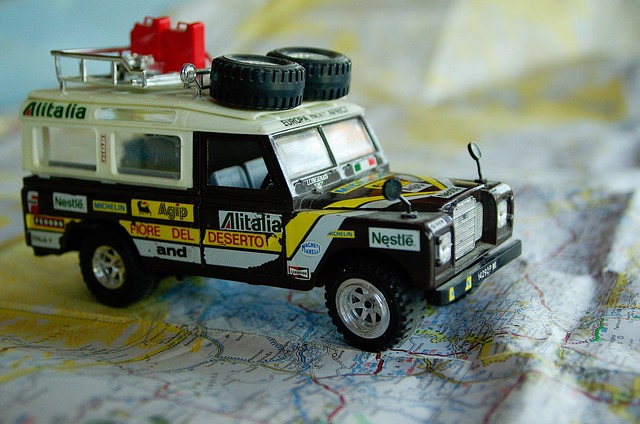Selecting, installing, and maintaining receiver hitches for 4x4s in McAllen requires expert guidance. Match hitch types (2" or 3") to vehicle specs, consult professionals, and ensure compatibility. Installation involves proper preparation, tool gathering, and secure mounting using jack stands. Receiver hitches offer versatility for off-road adventures, enhancing safety with even weight distribution. Common mistakes include clearance issues and poor security; high-quality hardware from reputable brands is crucial. Regular maintenance, including inspections and lubrication, prevents wear and ensures secure towing.
“Enhance your off-road capabilities with receiver hitches – the ultimate accessory for 4×4 enthusiasts. This comprehensive guide, crafted by an expert on 4x4s from McAllen, navigates the world of receiver hitches, offering insights to suit every need. From understanding the basics and choosing the right fit, to installation DIYers can handle, benefits that elevate your adventure, and troubleshooting tips for ongoing reliability – this is your one-stop resource for receiver hitch excellence.”
- Understanding Receiver Hitches: A Comprehensive Guide
- Choosing the Right Hitch for Your 4×4: Expert Tips from McAllen
- Installation Process: Step-by-Step Instructions for Beginners
- Benefits of Receiver Hitches for Off-Road Adventure
- Common Mistakes to Avoid During Hitch Setup
- Maintenance and Troubleshooting: Keeping Your Hitch in Top Shape
Understanding Receiver Hitches: A Comprehensive Guide

Receiver hitches are a crucial component for any off-roader or outdoor enthusiast, especially those who own 4×4 vehicles. As an expert on 4x4s in McAllen, we understand that these hitches serve as the connection point between your vehicle and the trailer or accessory you’re towing. They facilitate smooth towing, ensuring your rig remains stable and controlled during various terrain navigations.
When it comes to receiver hitches, knowledge is power. A comprehensive guide should cover basic types (like 2″ and 3″ hitches), installation processes, capacity ratings, and maintenance tips. Understanding these aspects allows you to choose the right hitch for your needs, install it properly, and maintain its longevity, ensuring safe and enjoyable off-road adventures or everyday hauling tasks.
Choosing the Right Hitch for Your 4×4: Expert Tips from McAllen

When equipping your 4×4 with a receiver hitch, selecting the right fit is paramount for both safety and functionality. As an expert on 4x4s in McAllen, we’ve seen firsthand how important this choice can be. The first step is understanding your vehicle’s specifications—weight capacity, hitch class, and tongue weight—to ensure compatibility. An incorrect match could lead to instability during towing, compromising your safety and the integrity of your rig.
Our team recommends consulting with a professional or referring to your owner’s manual for accurate measurement and classification. Additionally, factor in the type of trailer you plan to tow. Different hitches cater to various trailer styles and load capacities. By seeking advice from our expert 4×4 specialists in McAllen, you’ll gain valuable insights into choosing a receiver hitch that seamlessly integrates with your vehicle, enhancing both its performance and towing capabilities.
Installation Process: Step-by-Step Instructions for Beginners

Installing a receiver hitch is a task that many 4×4 enthusiasts tackle to enhance their vehicle’s versatility. For beginners, the process might seem daunting, but with the right tools and clear instructions, it can be accomplished successfully. Here’s a step-by-step guide tailored for those new to this task:
1. Prepare Your Vehicle: Start by washing your 4×4 in McAllen to ensure any debris or dirt is removed from the mount location. Dry the vehicle thoroughly, then locate the ideal spot for your receiver hitch. This usually involves identifying the existing bolting points on your vehicle’s frame. Use a visual reference guide if needed, and double-check that your chosen location aligns with your hitch’s specifications.
2. Gather Tools and Parts: Before you begin, make sure you have all the necessary tools, including jack stands, a floor jack, socket sets, wrenches, and your new receiver hitch. Ensure compatibility by cross-referencing your vehicle’s make, model, and year with the hitch’s specifications. An expert on 4×4 McAllen can provide valuable insights into the best fit for your specific vehicle.
3. Loosen Existing Components: Remove any covers or trim that might be in the way of access to the mounting points. Next, locate the existing bolts securing the factory-fitted components and loosen them using the appropriate socket and wrench. Take note of how these components are removed for future reference.
4. Position the Hitch: With your vehicle safely supported by jack stands, position the receiver hitch at the prepared mount location. Align the hitch’s holes with the corresponding bolt patterns on your vehicle. Ensure all hardware is properly seated before proceeding.
5. Secure the Hitch: Using your socket set and wrenches, tighten the bolts in a crisscross pattern to ensure even pressure and secure the hitch firmly to your vehicle. Follow the manufacturer’s torque specifications for optimal performance and safety.
Benefits of Receiver Hitches for Off-Road Adventure

Receiver hitches are a game-changer for off-road enthusiasts, offering unparalleled versatility and convenience during their adventurous treks. For an expert on 4×4 in McAllen or beyond, these hitches provide a secure and sturdy attachment point for towing trailers, allowing access to remote locations that would otherwise be unreachable. This is particularly beneficial when navigating challenging terrain, where the ability to carry additional gear or equipment can make all the difference.
One of the key advantages is their adaptability; receiver hitches can accommodate various trailer types and sizes, ensuring off-roaders can choose the right setup for their specific needs. Moreover, they enhance safety by allowing for proper distribution of weight, preventing issues like wheel lift or vehicle instability, which are common with subpar towing equipment. This level of security is crucial when venturing into unknown or unforgiving landscapes, providing peace of mind for adventurous souls who demand reliability from their 4x4s.
Common Mistakes to Avoid During Hitch Setup

When setting up a receiver hitch, even experienced off-road enthusiasts can fall into some common pitfalls. As an expert on 4×4 McCallen, I’ve seen many folks struggle with simple mistakes that could have been easily avoided. One of the most frequent errors is overlooking the importance of proper clearance. Ensure your vehicle’s underbody is free from obstacles to prevent damaging parts during towing. Another blunder is not securing the hitch tightly enough; a firm connection is crucial for safe towing and preventing unexpected detachment at high speeds.
Additionally, neglecting to use the right accessories or ignoring manufacturer guidelines can lead to complications. Always refer to your vehicle’s manual for specific recommendations. Using low-quality hitches or adapters might seem cost-effective initially, but they can fail under stress, posing serious safety risks. An expert on 4×4 McCallen recommends investing in reliable hardware from reputable brands to avoid these pitfalls and ensure a smooth towing experience.
Maintenance and Troubleshooting: Keeping Your Hitch in Top Shape

Maintaining your receiver hitch is crucial for ensuring safe and secure towing, especially for those seasoned off-road adventurers in 4×4 McAllen. Regular checks are key; inspect all hardware for any signs of wear or damage, and ensure all components are tightly secured. Lubrication is another essential part of upkeep; apply a suitable lubricant to the hitch ball and receiver to prevent corrosion and facilitate easy coupling.
When it comes to troubleshooting, even the most seasoned experts on 4×4 McAllen might encounter issues. Common problems include loose connections or damaged wiring, so always double-check electrical connections. If you’re experiencing difficulty when hooking up your trailer, consider these basic checks: ensure your hitch is properly aligned with the trailer coupler, and check that the safety latches are securely engaged.
Receiver hitches are a game-changer for off-road enthusiasts, offering versatility and durability. As an expert on 4x4s from McAllen can attest, choosing the right hitch and proper installation are key to enhancing your off-road adventures. By following the step-by-step guide and understanding the benefits outlined in this article, you’ll be well-equipped to navigate rugged terrains with confidence. Remember, proper maintenance and avoiding common setup mistakes will ensure your receiver hitch remains a reliable companion for years to come.
